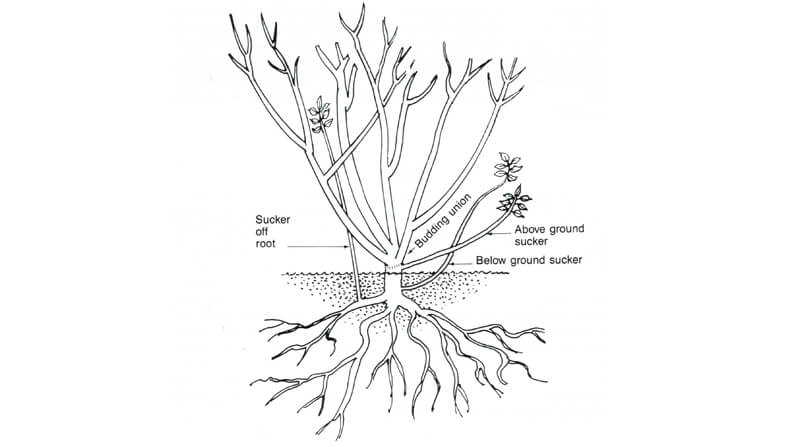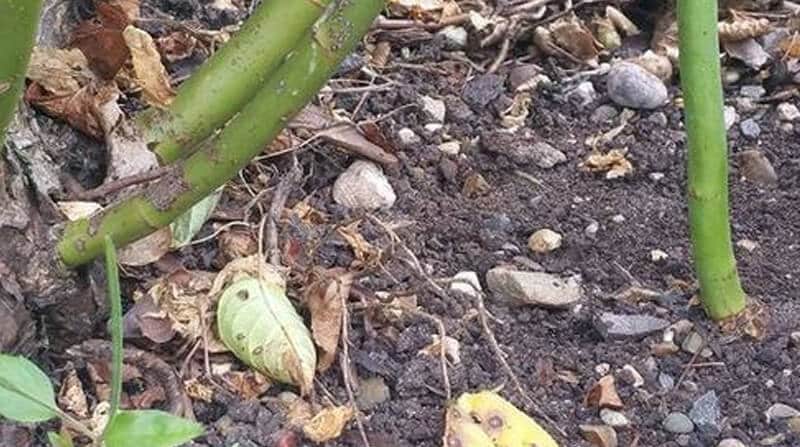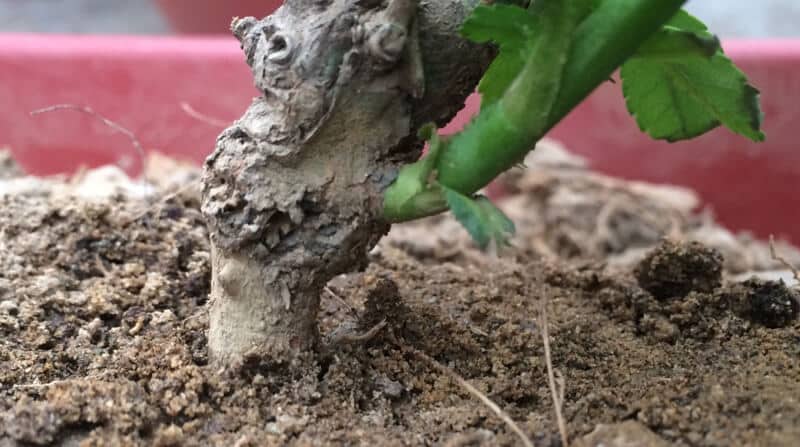Rose suckers are a fairly common problem.
They ‘suck’ the majority of nutrients away from the main rose bush. This weakens the main plant, sometimes to the point where it dies.
If you see suckers on your roses, you must get rid of them. However, simply cutting them off isn’t enough.
So in this article, I’m going to explain what rose suckers are, why they grow and how to identify and remove them.
What Are Rose Suckers?
Rose suckers are shoots that grow directly from the rootstock of a rose bush.
They’re usually caused by frost damage or by nicking the plant with a spade or other gardening tool.
You can easily identify them as they’re long and slender, they have thorns and leaves which are different from those of the main rose bush. They often appear to grow from the soil, sometimes several feet away from the bush. Make no mistake though, they will be attached below the surface.
In nearly all cases, rose bushes that suffer from suckers are grafted, or ‘budded’.
In order to fully understand what rose suckers are, why and how they grow, it’s best to understand what a grafted rose bush is.
What is a Grafted Rose Bush?

A grafted rose bush contains two parts of two different species of rose.
Often times the top part of a rose bush isn’t hardy enough to cope with our climate when grown on its own root system.
To get around this, the top part of the bush (the stems, leaves and flowers) are grafted, or budded onto the rootstock of an extremely hardy species of rose. This results in a rose bush that has the look and hardiness you desire.
In the image above from Treloar Roses, you can see the anatomy of a grafted rose bush. The part where the top part of the plant joins the rootstock is called the ‘Bud Union’ which often looks like a nobbly knot of wood.
It’s just under the bud union that rose suckers grow from.
3 Types of Rose Suckers
As you can see in the images above, there are three types of rose suckers.
- Off Root Suckers – These grow from the actual roots
- Above Ground Suckers – Grow below the budding union but you can see where they stem from
- Below Ground Suckers – Exactly the same as above ground suckers but you’ll have to remove the soil to see where they stem from
The way to deal with them is exactly the same.
Why it’s Important to Remove them as Soon as Possible
It’s important to remove rose suckers for two reasons;
- They’re Unsightly – Suckers grow differently and look completely different from the rest of the rose bush. They have a habit of growing tall and out of control, have a different leaf structure and colour and they don’t bud or flower. Suckers simply ruin the look of the plant.
- They Can Kill the Plant – If left to grow, rose sucker canes will ‘suck’ the nutrients needed for growth and development from the rose bush. This weakens the upper part of the bush, sometimes to the point where the whole thing dies.
The sooner you spot a sucker on your rose bush, the quicker you can deal with it and the healthier the bush will be.
How to Get Rid of Sucker Canes

Getting rid of rose suckers isn’t difficult, you just need to know how to do.
Like everything, however, there is a right way and a wrong way. Choose the wrong way and you’ll make the problem even worse.
So let me start by telling you how NOT to do it.
How NOT to Remove Suckers From Your Roses
Many people try to remove sucker canes by cutting them with a pair of secateurs.
Don’t do this.
Simply pruning rose suckers will only encourage them to grow back with more vigour.
In order to get rid of them and prevent them from growing back, you need to be bit more brutal.
The Correct Way of Removing Rose Suckers
If you follow these steps, you’ll get rid of the sucker cane and prevent any more from growing back.
Step 1: Dampen the Soil
Firstly, dampen the soil by watering it.
If the soil is hard and dry, digging it to reveal where the sucker is coming from will be difficult. This could result in you nicking the rootstock with your spade or trowel which will likely result in another sucker.
Dampening the soil will make it easier to dig.
If need be, dampen it over the course of a few days.
Step 2: Reveal Where the Sucker is Coming From
Dig the soil back to reveal where the sucker has sprouted from.
If possible, get a pair of gloves on and dig the soil by hand. Like I said, nicking the rootstock with a trowel or spade could result in more suckers being produced.
Digging by hand will ensure this doesn’t happen.
Step 3: Twist and Pull to Remove the Sucker Cane
Once you have revealed where the sucker is attached, break it off by twisting and pulling it.
You’ll need to wear a decent pair of gardening gloves to protect your hands from any thorns on the sucker cane.
The idea being the twisting and pulling is to damage that joint to the point where the sucker can’t recover.
Step 4: Seal the Wound
When you have removed the sucker, seal the damaged area with a tree wound sealer to protect it from the ingress of disease.
I like Bayer Garden’s Arbrex Seal & Heal.
Simply paint it on to the affected area.
- Pruning paint with easy to use brush applicator.
- Seals and heals pruning cuts on all types of trees
- Protects against ingress of diseases and harmful pests e.g. coral spot, silverleaf, etc
- Can be used down to -10°C
Step 5: Replace the Soil
Now you have removed the sucker and protected the damaged area of the rootstock, just replace the soil to cover the area.
Removing a sucker from a rose should really only take a matter of minutes. That said, it’s time well spent!



Hello,
I have ramblers and climbers with long growth well above the main root , these appear different from the main plant growth with seven leaves, I call them SUCKERS and
am unsure whether this terminology is correct. This growth appears not to provide any flower buds. Please advise me how to deal with this apparent unnecessary
growth.
I have the exact same problem as John Pickett on my climbing rose! The potential “suckers” are paler than the main plant, straight where the main plant is not and have 7 leaves per cluster as opposed to 5 on the main plant. They all originate above the bud area. Should I pull them off?
Many thanks,
Emma R
Not my idea of how to remove a rose “sucker”! Twisting, etc, painting the wound? Clear around the plant as mentioned, and after locating the “possible” sucker, pull it straight down, literally ripping it off the root. If one paints over the scar, bacteria invariably will build up between the injury and the paint. Cheers! [email protected]
I don’t know if I have suckers. There is two and long not thin though and there is flowers on them. My husband reakons they are but have never seen flowers on suckers before. Any help would be appreciated
I just removed a hybrid tea that had been taken over by suckers. Some large, woody roots remain. Should I plant a new rose bush in that spot?
Never plant a rose in the same place as an old one unless considerable time (year?) has elapsed. The ground around an old rose is said by old fashioned gardeners to be “rose sick” and you will have problems with your new rose.
I have standard roses and on the one I have big spears on the side of the long steam half way up whot to do please